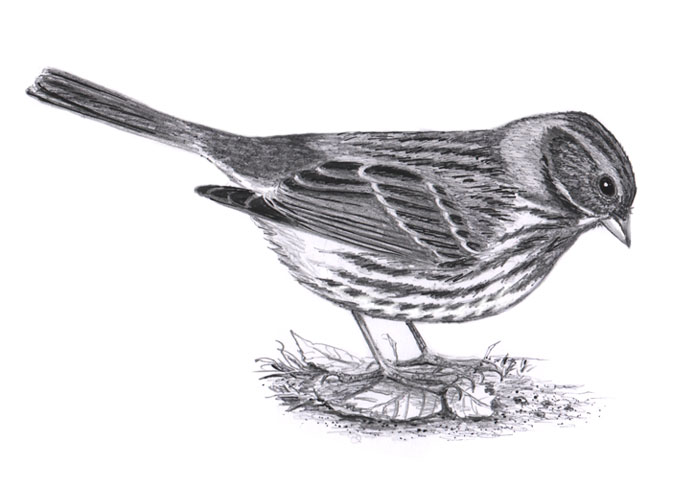
Dear Bird Folks,
Please find the attached photo. It’s a Fox Sparrow, a new bird for my yard, and I’m super excited to see it. Is there any special food I can put out to keep it around for a while?
– Susan, Needham, MA
Good for you, Susan,
When it comes to backyard birds, sparrows are on the lower end of the interest scale. We all press our faces against the window to see a hawk, or a hummingbird or an oriole, but a sparrow could be juggling fire and most people won’t even give it a second look. Sorting out their various shades of brown, gray, brown, white, brown and brown is just too tricky for most folks to deal with…and Fox Sparrows maybe the trickiest of all. They have so many plumage variations that even the experts are left scratching their heads. At least, I hope that’s why they’re scratching their heads.
Darker “Sooty” Fox Sparrows are found along the Pacific Coast, while a lighter “slate-colored” race lives in the Rockies. California has its own “thick-billed” race. In the East, we have the “red” race of Fox Sparrows. Instead of being covered in sparrow-brown, they are rufous colored and hence the origin of the “fox” moniker. Nearly the size of a Hermit Thrush or towhee, the Fox Sparrow is noticeably larger than our other backyard sparrows. And like towhees, they habitually scratch while foraging. After grabbing leaf litter or soil with both feet, they will then kick the dirt backwards, like a dog that has just finished, um…doing what dogs do.
Even though they are common and widespread throughout the continent, finding a Fox Sparrow is not always easy. Here in Massachusetts they are basically winter visitors, migrating south each fall from their breeding grounds in northern Ontario, Quebec and the Maritime Provinces. They also tend to be more reclusive than some of their other sparrow cousins. Instead of eating in open fields or along roadsides, Fox Sparrows forage under dense vegetation, especially near swamps and wetlands. But, if you’re lucky, they will occasionally visit backyard feeders. Or, more accurately, they’ll visit the ground below backyard feeders, if those feeders happen to be near thick cover. What seeds do they like? Typically, they avoid sunflower seeds if the sunflowers are still in the shells. That’s a little surprising considering much smaller birds such as chickadees, nuthatches and goldfinches can easily open the tough sunflower shells, but Fox Sparrows don’t seem to possess those skills. Instead, they would rather eat cracked corn or white millet. Speaking of millet: this brings up a topic that I never thought I’d have to write about.
For decades, you have heard me rant against the dreaded “mixed” birdseed. Most feeder birds would much rather eat sunflower seeds, but sunflower is expensive, so many companies add less costly ingredients in order to keep the price down. They don’t care if the birds eat the stuff or not, they just want to advertise a lower price. One of the most common ways to “water down” a bag of birdseed was to add copious amounts of cheap white millet. Well, those days are over. An apparent millet shortage (thanks, 2020) has driven the price so high that mixed birdseed is now being watered down with sunflower seeds. Really. That’s a shocker to me. It’s like a seafood joint stuffing more lobster meat into a lobster roll just to cut down on the amount of lettuce used. (Although I’d still rather eat the lettuce.)
A few years ago, there was a Fox Sparrow digging in the garden behind our shop. It was a treat to see the reclusive bird in an area that is typically inundated with the more urban House Sparrows. What was the Fox Sparrow eating? We didn’t really have a feeder in that garden, but we did toss old floor sweepings back there. Unsurprisingly, these sweepings contained large amounts of spilled seed, including millet. We don’t do that anymore, however. The soaring seed price resulted in too many people fighting the birds for the tossed floor sweepings. It was starting to get ugly.
Other than that one garden visitor, Susan, I don’t have any firsthand experience with Fox Sparrows coming to my feeders. But the word on the street is that they tend to be loners and not found in flocks. They are also a bit restless, often staying around for a week or so before moving on. In the meantime, the best you can do to keep your sparrow happy is to scatter cracked corn or millet on the ground for it to scratch up. Cracked corn is still reasonably priced and is available in bags as large as fifty pounds. White millet used to come in fifty-pound bags also, but now it is sold by the gram and only under tight security.
On a different topic:
One of the most often asked questions this time of year is whether we might expect to see Snowy Owls in our area this winter. The short answer is, no. A food shortage in Canada has forced many other species to migrate south, but that’s not how it works with Snowys. We actually see them more often when food is abundant and the breeding season is a success. But when there is less food (no lemmings), like there was this year (thanks again, 2020), adult owls produce fewer babies. As a result, Snowy Owl sightings will likely be scarce this winter…but not as scarce as white millet. This winter it might be cheaper to fill your feeder with lobster.